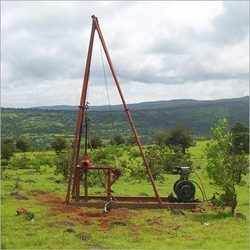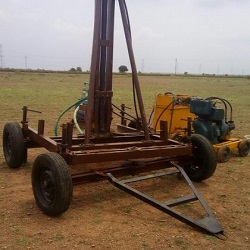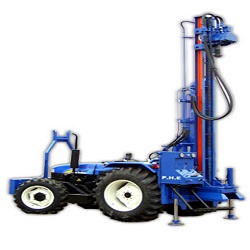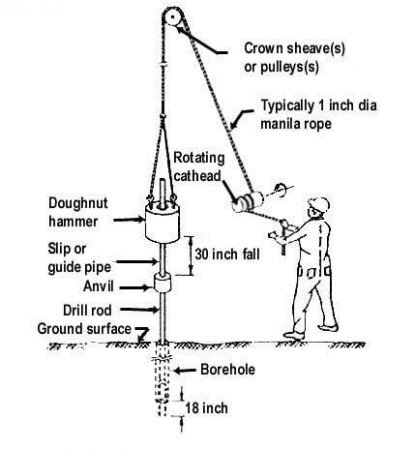


Standard Penetration Test (SPT) The standard penetration test is an in-situ test that is coming under the category of penetrometer tests. The standard penetration tests are carried out in borehole. The test will measure
the resistance of the soil strata to the penetration undergone. A penetration emphirical correlation is derived between the soil properties and the penetration resistance. The test is extremely useful for determining
the relative density and the angle of shearing resistance of cohesionless soils. It can also be used to determine the unconfined compressive strength of cohesive soils. Tools for Standard Penetration Test.
The requirements to conduct SPT are:
Standard Split Spoon Sampler
Drop Hammer weighing 63.5kg
Guiding rod
Drilling Rig.
Driving head (anvil).
Procedure for Standard Penetration Test:
The test is conducted in a bore hole by means of a standard split spoon sampler.Once the drilling is done to the desired depth, the drilling tool is removed and
the sampler is placed inside the bore hole.
By means of a drop hammer of 63.5kg mass falling through a height of 750mm at the rate of 30 blows per minute, the sampler is driven into the soil. This is as per
IS -2131:1963.
The number of blows of hammer required to drive a depth of 150mm is counted. Further it is driven by 150 mm and the blows are counted.
Similarly, the sampler is once again further driven by
150mm and the number of blows recorded. The number of blows recorded for the first 150mm not taken into consideration.. The number of blows recorded for last two 150mm intervals are added to give the standard penetration
number (N). In other words,
N = No: of blows required for 150mm penetration beyond seating drive of 150mm.
Standard penetration Test:
Fig.1: Standard penetration Test
If the number of blows for 150mm drive exceeds 50, it is taken as refusal and the test is discontinued. The standard penetration number
is corrected for dilatancy correction and overburden correction.

Plate load test is a field test, which is performed to determine the ultimate bearing capacity of soil and the probable settlement under a given load. This test is very popular for selection and design of shallow foundation. For performing this test, the plate is placed at the desired depth, then the load is applied gradually and the settlement for each increment of load is recorded. At one point a settlement occurs at a rapid rate, the total load up to that point is calculated and divided by the area of the plate to determine the ultimate bearing capacity of soil at that depth. The ultimate bearing capacity is then divided by a safety factor (typically 2.5~3) to determine the safe bearing capacity.






© 2019 Narendra Geotechnical. All rights reserved